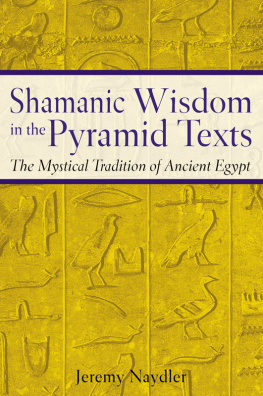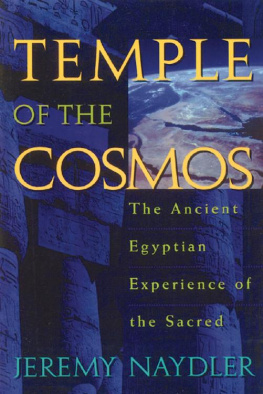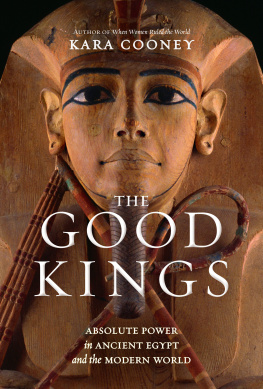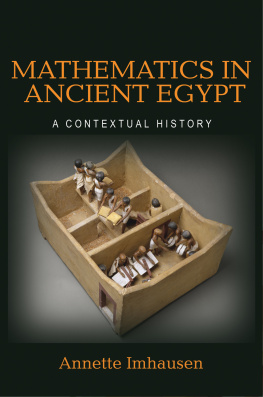
CONTENTS
APPENDICES
ABBREVIATIONS
| ADAIK | Abhandlungen des Deutschen Archologischen Instituts AbteilungKairo |
| gAb | gyptologische Abhandlungen (Cairo) |
| AN | Archo-Nil (Paris) |
| ASAE | Annales du Service des Antiquits de lgypte (Cairo) |
| BAAA | Le Bulletin Annuel de LAtelier dAlexandre (Alexandria) |
| BBA | Beitrage zur gyptischen Bauforschung und Altertumskunde (Cairo and Wiesbaden) |
| BD | The Book of the Dead. For translations, see bibliography. |
| BO | Bibliotheca Orientalis (Leiden) |
| CH | Corpus Hermeticum. For translations, see bibliography. |
| CT | The Coffin Texts. For translations, see bibliography. |
| CW | Collected Works of C. G. Jung (Bollingen Series XX), 20 vols., trans. R. F. C. Hull, ed. H. Read, M. Fordham, G. Adler, and W. McGuire (Princeton: Princeton University Press, 19531979) |
| DE | Discussions in Egyptology (Oxford) |
| JARCE | Journal of the American Research Center in Egypt (New York) |
| JEA | Journal of Egyptian Archaeology (London) |
| JNES | Journal of Near Eastern Studies (Chicago: University of Chicago Press) |
| JWCI | Journal of the Warburg and Courtauld Institute (London) |
| KMT | KMT: A Modern Journal of Ancient Egypt (San Francisco) |
| L | Lexikon der gyptologie, 7 vols., ed. W. Helck and E. Otto (Wiesbaden: O. Harrassowitz, 197589) |
| MS | Mnchner gyptologische Studien |
| MDAIK | Mitteilungen des Deutschen Archologischen Instituts, AbteilungKairo (Mainz: Verlag Philipp von Zabern) |
| NHC | Nag Hammadi Codices. For translation, see J. M. Robinson, ed., The Nag Hammadi Library in English. |
| OMRO | Oudheidkundige Mededelingen uit het Rijksmuseum van Oudheden (Leiden: Rijksmuseum van Oudheden) |
| Or | Orientalia (Rome: Pontificium Institutum Biblicum, 1920) |
| PT | The Pyramid Texts. For translations, see bibliography. |
| RAIN | Royal Anthropological Institute News (London) |
| RHR | Revue de lhistoire des religions (Paris) |
| SPAW | Sitzungsberichte der Preussischen Akademie der Wissenschaften,Philosophisch-historische Klasse (Heidelberg) |
| UGA | Untersuchungen zur Geschichte und Altertumskunde gyptens (Leipzig and Berlin) |
| Utt. | Utterance of Pyramid Texts, as cited in R. O. Faulkner, The Ancient Egyptian Pyramid Texts (Oxford: Oxford University Press, 1969) |
| Section of Pyramid Texts, as cited in K. Sethe, Die altgyptischen Pyramidentexte, 4 vols. (Leipzig, 19081922), often referred to in Egyptological studies as Pyr. Sethes divisions are also followed in the translations of Mercer, Piankoff, and Faulkner. |
| ZS | Zeitschrift fur gyptische Sprache und Altertumskunde (Leipzig, Berlin) |
PREFACE AND ACKNOWLEDGMENTS
This book began seven years ago with the overly ambitious aim of reinterpreting not only the Pyramid Texts, but also the Coffin Texts and the Book of the Dead, seeing them as documenting mystical experiences rather than simply funerary beliefs. As research progressed, and the original project was transformed into a Ph.D. thesis in religious studies, its scope narrowed to a reinterpretation of the Pyramid Texts alone and, like previous interpreters, I found myself gravitating to the texts in the pyramid of Unas. At the same time, I also had to think a great deal more about mysticism and the methodologies appropriate to studying it. The Ph.D. thesis, entitled Mysticism in Ancient Egypt: the Pyramid Texts Re-examined, forms the basis of the present book. While I have reduced the number of references, cut out or rewritten various sections, and generally tried to streamline the prose, the lineaments of the doctoral thesis are never far beneath the surface. This is not therefore a popular book on ancient Egyptian mysticism, nor was it ever intended to be. Egyptian mysticism is both too serious and too neglected a subject to be taken lightly, and the stakes are too high to warrant anything less than a thorough reexamination of the source material, and a comprehensive critique of the way this has been interpreted within Egyptology during the twentieth century.
I wish to express my profound gratitude both to the supervisor of my thesis, Dr. Leon Schlamm, and to Dr. Alison Roberts, who kindly agreed to take on the role of Egyptological consultant. I could not have wished for two more committed guides, who have been as demanding and challenging as they have been inspirational and supportive. Through their conscientiousness and meticulous attention to detail, I have been saved from countless errors and pointed toward new avenues of reflection and research. Where errors and shortcomings remain, the responsibility for them is mine alone.
My thanks also go to Louanne Richards for her loving support and ; and to Maura Maguire for hearing various chapters and for the warmth and consistency of her encouragement, especially during the long bleak weeks of the siege of Stalingrad. Thanks also to Allegra Wint for her crucial help during the last year.
My first real engagement with the texts of the pyramid of Unas was between 1991 and 1993, during which time a small group of us met regularly to read and discuss them. To the members of this groupHlne Goodfellow, James Hunt, Jean Semlyen, Dr. Felix Padel, and Anthea BazinI owe a debt of gratitude, for those meetings planted the seeds of this book. I am also grateful for the comradeship of K. A. and Anthea Bazin over years of struggling with the Unas hieroglyphs, as well as for the rich discussions this entailed. My indebtedness extends to so many students over the years, at Reading and Southampton Universitiestoo many to name but without whom I doubt if this work would have been embarked upon. I mention only the late Peter McGhie, who had the rare ability, when reading the Pyramid Texts, to convey the awesome, archetypal power of their content to all who were present.
I am grateful also to the late Dr. Kathleen Raine, who supported my initial application to work toward the Ph.D., and thereafter provided many opportunities for me to share this work through the Temenos Academy, and was consistently supportive over many years. I am grateful, too, to Stephen Overy, administrator of the Temenos Academy, for arranging the series of London seminars on the Pyramid Texts between 2001 and 2003, at which it was possible to experience just how alive the Pyramid Texts can be today, as well as to share and receive feedback from the various participants on work that was by then already well advanced.
I am grateful to both Dr. Alison Roberts and Claudia Bse for their help with translations of several long passages of German text, and to Iain Geddes for kindly volunteering to produce figure 8.8. I want also to express my gratitude to my mother, Elizabeth Naydler, for financial assistance during the first year of the thesis.
While this book steers a course that is in many ways counter to that of mainstream Egyptology, I am nevertheless indebted to the generations of Egyptologists who have dedicated themselves to discovering, transcribing, editing, translating, and commenting upon the Pyramid Textsin particular, Gaston Maspero, Kurt Sethe, Samuel Mercer, Alexandre Piankoff, and R. O. Faulkner, without whose labors the present study would not have been possible. I would like also to acknowledge the contribution of the non-Egyptologist William Fix, whose analysis of the Unas texts in his book
Next page









